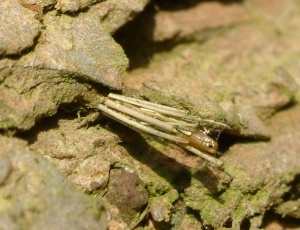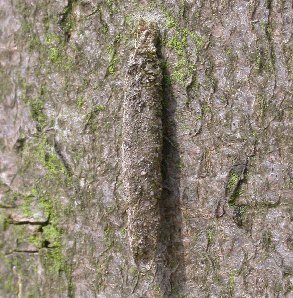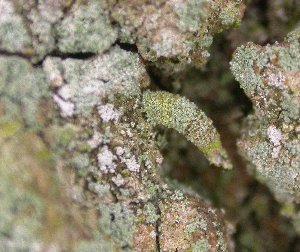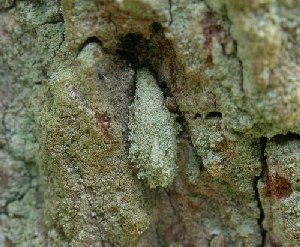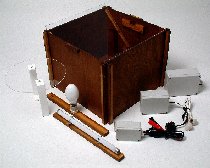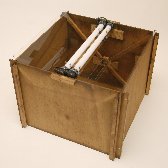Reports
from Recorders around the county
Records reported in
this section have not been checked by the Suffolk Moth Panel. Many
thanks go to the recorders who provide write-ups and records for this
section.
Mendlesham Green, September
to year end 2008 - Steve Woolnough
Poor weather and a holiday meant that
the trap was run on only six nights before the end of the year.
However, there was still a new garden record with Mompha sturnipennella recorded on
27th September. The last Silver Y of the year appeared on 9th October
and after a complete absence of Common Plume during the year, three
were in the trap on 11th October. On 17th October, four Merveille du
Jour occurred, the highest total recorded in the garden. The trap was
last run on 14th November, when a Yellow-line Quaker and two Feathered
Thorn were captured. The last moth of the year was an Agonopterix arenella seen on 8th
December.
Five mines new to the garden were recorded during October (thanks to
Neil Sherman for the idents). These were Stigmella anomalella (Rose Leaf
Miner), Stigmella crataegella,
Parornix anglicella, Phyllonorycter oxyacanthae and Phyllonorycter corylifoliella.
Including mine records, the species total for the year was 319, the
highest total since 2005.
After six years of garden trapping, the species total now stands at 535.
Eye Moths, late August to February 2009 -
Paul
Kitchener
August
A run of several warm nights during the last week of August produced a
flurry of good garden records. On the 26th there were first site
records for
Aproaerema anthyllidella
and Saltern Ear (the identification of both confirmed by Jon Clifton)
and to follow on the 27th were two more firsts,
Dichrorampha simpliciana (also
checked by Jon) and
Pyrausta
despicata. The 28th was not to be outdone, with yet two more
garden firsts (and yet more work for Jon) in the shape of
Ectoedemia louisella and
Cosmiotes consortella. Also on the
28th there was
Acrolepiopsis
assectella (the fourth site record and second of the year) and
the second site record of Narrow-winged Pug (and only the third I’ve
seen in Eye over the past thirteen years). Other bits and pieces at the
tail end of August were
Bucculatrix
thoracella,
Ypsolopha sequella
(two on the 31st was a seventh record but the first since 2006),
Blastodacna atra (the second of
the month), Large Thorn (sixth site record, but only the second since
2003), Old Lady (fourth record and the third to come to MV) and a
single Red Underwing.

|

|
Blastodacna
atra © P Kitchener
|
Large Thorn © P Kitchener
|
September
Of the micros in September
Stigmella
obliquella was a first for the site whilst a
Caloptilia syringella on the 8th
was the third in a couple of weeks (there have been five records this
year but only three previously).
Phyllonorycter
leucographella may also be increasing locally as one this month
was the sixth of the year and the last year one was seen was 2003.
Another
Ypsolopha sequella
was good but only two
Plutella
xylostella were trapped making a very poor total for the year
(thirty-eight, the worst since 2005).
Coleophora
alcyonipennella (confirmed by Jon again) was a third site
record, the previous two were both in 2006 and an
Epinotia tenerana on the 23rd was a
second site record and a second for the year.
Epiphyas postvittana (fifteen this
month) was not recorded here until 2006 when six were seen, there were
ten in 2007 and thirty-seven in 2008, a steady increase pretty much
expected once the first ones arrived.
Whatever the weather and however poor the year there is always hope
that there will be the odd migrant or two turning up. This autumn it
has indeed been just the two, with a Vestal (third site record) on the
9th and a Dewick’s Plusia (first site record) on the 23rd.
Incidentally, twelve Silver Y were trapped in September, nearly half
the year total.

|

|
Caloptilia
syringella © P Kitchener
|
Dewick's Plusia © P Kitchener
|
A Clouded Border on the 8th was my latest ever (the first September
record was only last year), a Swallow Prominent on the 6th was the
first September record since 1999 and a Buff Ermine on the 7th was a
surprise as I had never recorded it later than July. Species occurring
this month that seem to have had a relatively good year include Dusky
Thorn (the highest numbers since 2003), Willow Beauty (the most ever at
this site), Frosted Orange (sixteen this month alone whereas there was
only one seen all of last year) and Burnished Brass (the most ever at
this site). Dark Spectacle would appear to be safely established around
here now, (the numbers for the years 2001 - 2008 being
0/1/0/4/10/10/10/20) and Orange Sallow had it’s best year following a
complete blank last year. Common Wainscot however had an
extraordinarily bad year; from a peak count of six hundred and ten in
2006 it has crashed to just nineteen seen this year, the first time it
has been outnumbered by Smoky Wainscot (which appeared in average
numbers), a species that I have always assumed would be affected in
much the same way by the vagaries of the weather.
October
I was away on holiday until the 10th and managed only twelve nights
trapping during the remainder of the month, so there is very little to
report. The night of the 13th produced the best catch with twenty
species that included Acleris rhombana (only the seventh site record
but second of the year) and my first October record for Small
Square-spot (there were two more to come on the 15th). Two other
species also appeared on their latest ever dates: Light Emerald (12th)
and Burnished Brass (19th). A White-point on the 19th was the last one
of the year and took the year’s total to thirty-six, the lowest number
since 2004. One noteworthy feature of the month appeared to be the high
numbers of Setaceous Hebrew Character relative to the year total
(62/698). The year 2006 was a bumper one for this species but
relatively few were seen in October (though well over one thousand were
seen in September), the equivalent figures being 28/4098.
November
There were some very mild nights this month, ten of the eleven nights
trapped having a minimum temperature above 8° C. As a consequence,
perhaps, a record total of twenty seven species was seen, easily
beating the previous record of twenty recorded in 2004. Of these, nine
were micros which included
Caloptilia
rufipennella and
Caloptilia
stigmatella, both being seen in November for the first time.

|
December Moth
© P Kitchener
|
Both Large and Lesser Yellow Underwing were trapped on the 3rd, the
first November record for the former and there were also the latest
ever records for Common Marbled Carpet (5th) and Pale Mottled Willow
(15th). More typical of the time of year were two December Moth (this
moth remains strangely rare around here, only thirteen individuals have
been seen in eight years), fourteen Feathered Thorn (more than twice
the very poor number seen last year), three Sprawler and three Brick
(of the seven this year, after none at all last year).
December
Six nights trapping produced just three species,
Emmelina monodactyla, Winter Moth
and Chestnut before proceedings were brought abruptly to a halt by the
cold weather. It would be mid-February before it would be worth a try
again and the last time I went for a whole month without at least
trying one night was January 2002.
February
Trapping resumed on the 15th and with night time temperatures holding
up well for the time of year continued to the month’s end. Fourteen
species were recorded, easily my best February count (the previous best
being nine for last year and 2003).

|

|
Acleris
cristana © P Kitchener
|
Pale Brindled Beauty © P Kitchener
|
An
Acleris cristana on the
16th was a first site record and the first I’d seen in Eye since 2000.
A Pale Brindled Beauty on the same night was the first of the year, a
total of thirteen being seen this month (ten on the night of the 17th)
whereas there was only one last year. Another surprise on the 17th was
two Spring Usher, a real rarity around here. There has only been one
previous record, in 2003. There was to be a third record, just a couple
of days later. A Dotted Border on the 18th was my earliest and a Grey
Shoulder-knot on the 20th was only the second February site record. The
mild conditions encouraged a
Caloptilia
rufipennella out of hibernation
on the 26th and the next night an Oak Beauty was not only the first I’d
seen in February but also only the second site record, the first as
recently as last year. And finally, the
Orthosias just scraped into
February with a single Common Quaker on the 28th.
Woolpit 2008: A quick tale of dark
clouds and silver linings - Paul Bryant
It’s been quite a while since I came up with some musings about my
garden trap so, with apologies in advance for the sterility of this
note, I thought I’d try and put just a few words together.
Several months ago, I was asked how many species had I recorded at
Woolpit? I never thought that there was would be a great deal of
difference between my old garden and the one here so, allowing for a
few variables and the fact that I left Thurston on 321, I guessed that
my Woolpit list was somewhere in the region of 350 - 375. Imagine my
surprise when I found out that it was actually just a couple short of
450. What was even more amazing was the fact that 21 of those turned up
in 2008 – and from only fifty nights trapping!

|

|
Diurnea
fagella © P Bryant
|
Oak Beauty © P Bryant
|
By far the most productive month was July, which accounted for the half
of the new arrivals, but things started back in March when I finally
picked up the enthusiasm to do some trapping and recorded
Diurnea flagella,
Agonopterix heracliana and
Acleris cristana. A much
anticipated first turned up on the 3rd April in the shape of a single
Oak Beauty and the end of the month brought another macro - a Brindled
Beauty. May’s editions were single Streamer, Red-green Carpet, Puss
Moth and Least Black Arches.
As I have already mentioned, July was the most productive month for new
species. It was also the most productive period in the garden full stop
in terms of nights trapped and species recorded. A European Corn-borer
on the 14th got the ball rolling. I then added Dark Umber (18th),
Phalonidia manniana,
Pammene fasciana and Slender Pug
(all on the 22nd),
Pyrausta despicta
and Oak Nycteoline (23rd),
Calamotropha
paludella (25th) and last but not least,
Phyllonorycter geniculella and
Scoparia subfusca (on the 30th).
The final addition to the garden list turned up at the beginning of
August, a single
Limnaecia
phragmitella.
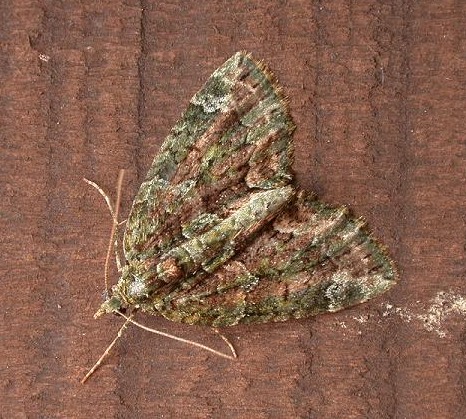
|
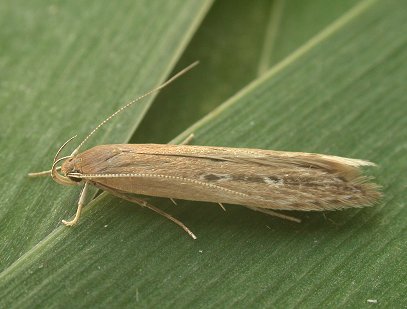
|
Red-green Carpet © P Bryant
|
Limnaecia
phragmitella © P Bryant
|
But that’s only 20 new species I here you cry. One other July addition,
which I thought was a garden first, has subsequently been pre-dated by
an early gen-det record -
Paraswammerdamia
lutarea.
Many of these moths are fairly common or widespread species. Whether it
was good old luck, or just plain and simple paying a bit more care and
attention to what was in the trap I cannot say (although I suspect the
latter) but, if I’ve learnt one lesson, then its tube it up. My thanks
as always to my long suffering wife who tries to share my enthusiasm
over ‘boring brown moths’ and to everyone who kindly helped identify
and confirm these additions along the way.
Happy trapping.
Paul
Moths at Ipswich Golf Course - July to
November 2008 - Neil Sherman
July
July 2008 bucked the trend for the preceding months – it was a very
good recording period, all due to the weather. Almost continuous warm
muggy conditions prevailed, with some violent thunderstorms towards the
end of the month. Traps were operated on 19 nights, resulting in a
species total of 422 (228 micros, 194 macros). This was much better
than 2007, when that wet month only produced 370 species. The best
night was the 14th, when 2 traps caught 174 species. The worst night
was the 20th, when unusually for the month the night was cold resulting
in only 25 species being noted in the garden trap.
A lot of survey work took place in the wetland areas of the site from
the middle of the month onwards, to try and determine the status of
White-mantled Wainscot after last year’s records. This included 2
site visits by members of the Suffolk Moth Group with their additional
traps to try and cover more ground, once at the end of July plus
another at the beginning of August. Unfortunately, despite all this
effort, no White-mantled Wainscots were seen, but the numbers of this
moth and some of the other wainscots have appeared in my experience to
be low this year, so more surveying will take place next year.
One of the benefits of the SMG visits was that sitting out with the
equipment meant that I could put out my wine ropes – these were
successful in attracting Old Lady moths both nights, a scarcely
recorded species here, and quite an impressive sight in the torch beam!
No new macros were noted during the month, but there were some notable
sightings all the same. There were second site records for the
following species: Lesser Cream Wave (2 on the 23rd) and Gold spot
(31st). Reed Dagger (31st) and Mullein Wave (30th) were third
site records. Also of possible interest were Leopard (4 seen on the
14th was a good count), Festoon (15 noted), Small Emerald (10th, scarce
here), Spinach (1st, only sighting in 2008), Small Waved Umber (29th,
fourth site record), Slender Pug (maximum count was 10 on the 23rd, the
highest ever recorded), Clouded Magpie (2 on 23rd during SMG visit,
first since 2006), Privet Hawk-moth (one only on 13th), Kent Black
Arches
(13 noted, maximum 4 on the 30th), Saltern Ear (30th), Webb’s Wainscot
(31st first for year), Small Rufous (24th), Shaded Fan-foot (5 only
noted) and a Dotted Fan-foot (14th). Note the number of interesting
wetland species there, showing where most of the recording took place!
Some species appeared to be at a low ebb at the site, 2 examples being
the Common Wainscot (1 only on the 14th) and the Pine Hawk-moth (6
noted, last year there were 64!). One moth however that appears to be
super-abundant in 2008 is the Black Arches, with the highest ever
figures recorded. The best count was the 60 seen on the 31st!
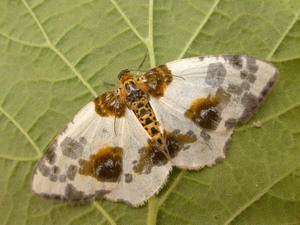
|
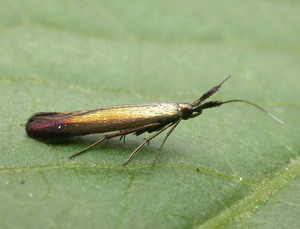
|
Clouded Magpie © N Sherman
|
Coleophora
deauratella © N Sherman
|
Micro numbers really took off in the traps during the month, with many
being tubed up for later examination. Not surprisingly some new
species were discovered.
Phyllocnistis
saligna (30th),
Coleophora
deauratella (15th),
Coleophora
hemerobiella (5 records) and
Plodia
interpunctella (the Indian Meal Moth – 15th) were all
identified.
Other interesting species included
Morophaga
choragella (3 records),
Argyresthia glaucinella (17th
first since 2006),
Ypsolopha
nemorella
(14th, first since 2003),
Agonopterix
ocellana (31st),
Thiotricha
subocellea (3 records, first since 2006),
Dystebenna stephensi (29th,
second site record),
Epiblema
foenella (22nd, scarce here),
Grapholita
funebrana (1st, second record after the first last month),
Agriphila
selasella (31st),
Evergestis
pallidata (the 4 seen on the 23rd were the
first since 2004),
Ostrinia nubilalis
(4 noted),
Vitula biviella
(28
recorded, down on last year’s figures),
Capperia britanniodactyla (6
seen at light, a good count) and
Adaina
microdactyla (2 records, scarce
here). There was a small invasion of ermine moths during the month,
with quite a few
Yponomeuta rorrella
seen, with a maximum of 20 noted
on the 26th. Also found was an
Yponomeuta
cagnagella (27th), a second
site record. A smaller number of
Acrolepiopsis
assectella were noted,
mostly in the garden trap with a maximum of 3 on the 15th. These can
probably be attributed to the onions and leeks growing in our
allotment!
Daytime observations included 2 sightings of Yellow-legged Clearwing
drawn to their specific pheromone lure. Lures were tried many times for
other species both here and at many other sites across Suffolk with
little success – it seems 2008 was a poor clearwing year (in my
experience anyway). On the 23rd, a few Chevron were seen flying around
on one of the heathland areas of the site, these being the only ones
noted as most of the recording with traps took place away from these
places.
August
August continued the trend of good moth recording, with mild conditions
dominating the month. Coupled with almost constant cloud cover, even at
night, this produced some excellent results. Some of the cloudy nights
were also wet, especially early on, but this did not make too much
difference to the numbers. The last week was especially good,
with most nights being warm and humid – lots of moths were trapped
then, including some new species (more on this later). The micro moths
certainly seemed to be present in good quantities again, just like in
July, with many needing later examination to determine what they were.
Traps were operated on 17 nights, with some trapping sessions taking
place at other habitats around the site. 329 species were noted (149
macros, 180 micros), this being the best August total since 2004 when
355 species were seen.
Another visit by members of the Suffolk Moth Group with their traps
took place on the 2nd, covering the reed-bed again (see the July report
for information on this). This night also produced the highest count
for the month, with 130 species recorded.
Macro records of possible interest for the site included the
following. Satin Wave (6th), Sharp-angled Peacock (5 recorded),
Bordered Beauty (3 seen), Pine Hawk-moth (the last and only one for the
month was noted on the 6th, only the seventh seen in 2008), Black
Arches (noted every night still with a maximum of 25 seen on the 6th),
Kent Black Arches (last one on the 11th), Dark Sword-grass (2, both in
the last week), Large Yellow Underwing (abundant, with numbers every
night during the last week exceeding 100), Square-spotted Clay (17th
and 24th, both in the garden trap), Six-striped Rustic (4 seen),
Square-spot Rustic (another species abundant in the last week), Heath
Rustic (26th), Hedge Rustic (recorded most nights from mid month with a
maximum of 15 seen on the 26th), Feathered Gothic (6 so far in the last
few days of the month), Common Wainscot (8 only, a poor count), Coronet
(2nd, second site record), Marbled Green ( also 2nd, second site
record), Old Lady (2 on wine ropes 2nd), Twin-spotted Wainscot (2 on
6th), Brown-veined Wainscot (2 on the 2nd with another on the 6th),
Webb’s Wainscot (6 recorded) and Dark Spectacle (19th and 21st, in
garden trap).
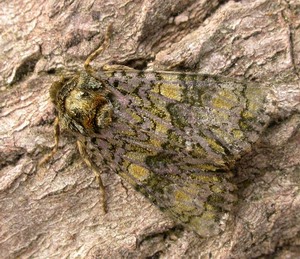
|
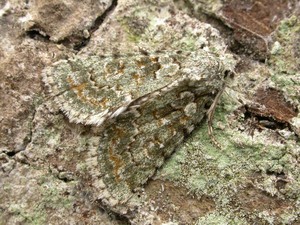
|
Coronet © N Sherman
|
Marbled Green © N Sherman
|
On the micro front, five new species were recorded. First was an
Oncocera semirubella on the
5th, rescued from a soaking wet trap after
a lot of heavy rain overnight. This was followed the next night (6th)
by
Agonopterix conterminella,
a species I’d not seen anywhere before.
The warm humid conditions during the last week produced the other
three:
Conobathra tumidana
(25th),
Cochylimorpha straminea
(26th) and
an
Ancylosis oblitella (28th,
a female). There were many more
interesting species recorded, here are a selection of the other
highlights.
Caloptilia populetorum
(3 recorded),
Phylloncnistis saligna
(4th, second record after the first last month),
Yponomeuta rorrella (5
more noted all in the first week),
Orthotelia
sparganella (6th, second
site record),
Acrolepiopsis
assectella (4 more, probably coming from my
allotment again!),
Coleophora
hemerobiella (6th, first records only
last month),
Recurvaria nanella
(7th, second site record),
Blastobasis
adustella (commonest moth in the trap all month, with a high
count of
300+ on the 5th),
Spilonota laricana
(25th, second record),
Cydia
amplana (6th, the third site record of this migrant),
Agriphila
selasella (2 records),
Synaphe
punctalis (a count of over 300 on the
2nd, most in one trap placed on an area of regenerating heather),
Vitula biviella (2 on the 7th
were the last recorded) and
Euleioptilus
carphodactyla (2nd, second site record).
Daytime observations included the discovery of a mine of
Heliozela
hammoniella on the 4th (a new site record) – this is a species
that
mines the stalk of a birch leaf before moving into the leaf blade to
cut out an oval case. A Red Underwing was discovered at rest on the
work-shed wall on the 20th, and was shown to the other staff who were
suitably impressed by this spectacular species. Finally several
caterpillars of the Elephant Hawk-moth were found feeding on
Willow-herb in an area of open fen.
September
September 2008 started very wet, not good weather for trapping moths.
This was followed by a short spell of warmer nights with some good
trapping. This period came to an end when cool, clear nights prevailed
until the very end of the month when conditions improved again. Traps
were operated on 14 nights, resulting in a total of 134 species (77
macros, 57 micros). This was lower than 2007, when 148 species were
recorded. The best night total was on the 11th, when 41 moth
species were trapped.
Towards the end of the month, searching of patches of ivy blossom after
dark commenced, producing some good moth records for the site (more on
this later). Best moth of the month was the Dusky-lemon Sallow trapped
on the 29th in the garden, a new species for the site. Other macros of
note included the following. Least Carpet (11th, latest ever),
Red-green Carpet (numerous both in the traps and on ivy, maximum 10 on
the 29th), Streak (11th – first for year), Feathered Thorn (24th and
28th, first records for the year), Mottled Umber (8th, earliest record
ever, followed by another on the 16th), Lesser Swallow Prominent (11th,
a late individual), Lunar Yellow Underwing (one only on the 10th),
Heath Rustic (5 records), Feathered Gothic (14 noted, with the 6 last
month this is a welcome recovery in numbers), L-Album Wainscot (13th
and 29th – both seen in the garden trap), Black Rustic (2 records),
Merveille du Jour (29th, first one for the year), Brindled Green
(regular, with a maximum of 17 on the 29th), Dark Chestnut (28th on
ivy), Brick (7 seen, all on Ivy – none at all in the traps), Flounced
Chestnut (28th), Brown-spot Pinion (23rd on ivy, first record since
2000), Red Underwing (10th). Some of the sallows seemed to be
around in good numbers this year, especially the Orange. 32 were
recorded, with a maximum of 6 seen on ivy on the 29th. Others seen were
Barred (9), Pink-barred (3) and Sallow (12). No Centre-barred were seen
at all, but this is a rare species at this site.
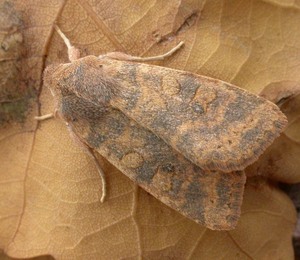
|
Dusky-lemon Sallow © N Sherman
|
Micros reduced in numbers, mainly dominated by commoner species. A few
things of note were recorded, and included
Ypsolopha sylvella (2
records),
Depressaria heraclei
(8th, second site record),
Acleris
sparsana (28th, first record for the autumn),
Eudonia pallida (11th)
and
Eudonia angustea (5
records, a good number). There were also 2
records of
Pandemis cerasana
and
Archips podana, possible
second brood
individuals.
October
October started cold, but mild conditions soon returned for a short
while, with some good counts of moths seen. It then turned cold again
with some frosts, mixed in with some windy and wet weather reducing the
trapping opportunities. Lights were operated on 9 nights, and checking
the ivy patch in the garden continued on from last month, this
producing a combined list of 62 species (13 micros and 49 macros). This
was better than the total for 2007, when 56 species were noted, but
there were more colder nights then. The best night was the 9th, when 28
species were recorded in the garden trap.
Moths of possible interest seen included the following. The Mallow was
first seen on the Clubhouse wall by the security lights on the 10th,
with the first in the trap on the 19th. The first November Moth agg.
seen was on the 10th, followed by a scattering of others. Four more
Streak were noted after the first last month. The warm conditions
produced the odd wanderer – a Dark-sword Grass was seen on the 6th,
followed by an L-Album Wainscot on the 10th (the third record for
2008). The Square-spot Rustic noted on Ivy on the 23rd is the latest
record for the site, beating last year’s late record on the 15th by
some margin. Grey Shoulder-knot was noted on Ivy as well as at light,
being seen on four dates. The Blair’s Shoulder-knot was seen regularly
with a maximum of 5 on the 7th. The Green-brindled Crescent was also
noted on ivy and at light, with a maximum of 3 on the 19th, 2 of which
were the dark form. The Merveille du Jour was seen on 8 dates, a good
count. The Brindled Green continued to be present in good numbers
following on from last month, with a maximum of 20 on the 6th at light.
Only one Large Ranunculus was noted on the 6th. The Satellite was first
seen on the 7th, and was seen at light and at ivy regularly after that.
The Chestnut too was noted around the same time, with a maximum of 50
seen on ivy on the 7th, good to see back in numbers after a poor season
last year. Mixed in with the Chestnut were a few Dark Chestnut, all
seen on ivy. The Brick was another moth that was recorded more commonly
on ivy, with up to 10 noted – there was only one at light on the 13th.
The first Red and Yellow-line Quakers were noted on the 4th, and were
seen regularly after that at light and ivy. In fact the Yellow-line was
one of the commonest species noted on ivy, with a maximum of 60 seen on
the 25th. Highest count in the trap was only 17. More Flounced Chestnut
were seen, with a maximum count of 3 on the 7th. Only one Large
Wainscot was seen on the 12th, continuing the downward trend of the
other Wainscot species here. It was nice to see the sallows continuing
to appear in good numbers following on from last month. There were 12
sightings of Orange, 35 of Barred, 6 of Pink-barred and 8 of the
Sallow. Moth of the month had to be the Red-green carpet. Never have I
seen so many – 102 were noted during the month, both on ivy and at
light. It was seen every trap night, with a maximum of 17 on the 14th –
it was the second commonest moth in the trap that night, only beaten by
the 18 Pine Carpets!
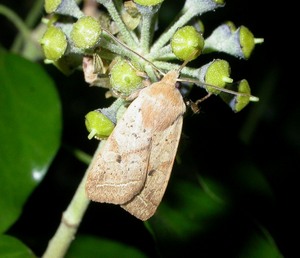
|
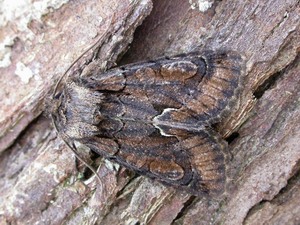
|
Yellow-line Quaker © N Sherman
|
Green-brindled Crescent © N
Sherman |
Few micros were recorded, with the
Caloptilia
stigmatella (8th, on ivy)
and
Ypsolopha sequella (2 on
the 6th at light) the only ones of some
interest.
November
Traps were operated on five nights, producing a species list of 23.
This was better than 2007, when only 15 species were noted. Best night
was the 2nd, when 2 traps caught 14 species. Most of the usual suspects
for the time of year such as December Moth and Feathered Thorn were
caught. Of possible note were sightings of a few more Red-green Carpet
(four – with the total for 2008 at the month’s end at 147!) and Streak
(eight noted). A search of some tree-trunks on the course by torchlight
on the mild night of the 26th revealed a big hatch of Winter Moths –
over 150 were seen, with some still drying wings. At least 60 mating
pairs were also found, the males attached to the wingless females. A
wingless female Scarce Umber was also discovered, the first time one
has been seen on the site.
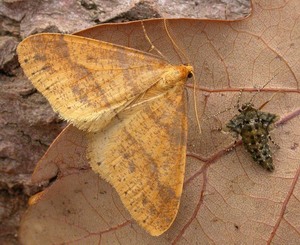
|
Scarce Umber - male and female © N
Sherman
|
There were only the odd sightings of Winter Moth and Scarce Umber
during December, mainly at lighted windows. No traps were operated due
to the poor weather.
The species count for 2008 was 683 (340 macros, 343 micros), higher
than 2007 with its 640 species. This shows that the year wasn’t as bad
as first thought for species, although numbers of individuals of moths
were lower in the traps. 28 new species were recorded (3 macros, 25
micros). The site Lepidoptera species total at the end of the year
stands at 1096 (1065 moths).
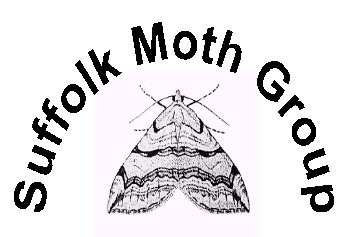




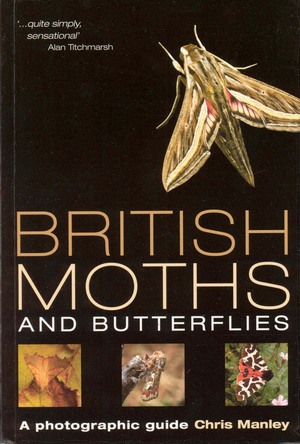 This
new book on Lepidoptera fills a vacant niche in the market.
Skinner has photographic plates of set moths, while the Waring guide
shows colour plates of moths in their resting positions. This book has
colour photographs of moths (and Butterflies) in their resting
postures, providing more help in identifying an unknown species.
This
new book on Lepidoptera fills a vacant niche in the market.
Skinner has photographic plates of set moths, while the Waring guide
shows colour plates of moths in their resting positions. This book has
colour photographs of moths (and Butterflies) in their resting
postures, providing more help in identifying an unknown species. 